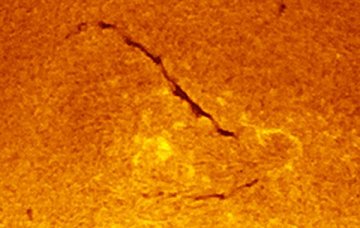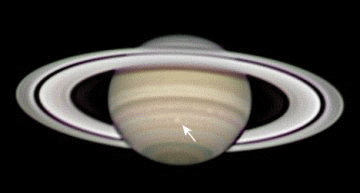 Would you like a call when SuitSat is about to glide overhead? Sign up for SpaceWeather PHONE.
Would you like a call when SuitSat is about to glide overhead? Sign up for SpaceWeather PHONE.
SUITSAT: A strange satellite is about to go into Earth orbit. It's "SuitSat," an empty spacesuit thrown overboard from the International Space Station. Using a simple police scanner or ham radio, you can listen to SuitSat when it orbits over your hometown.
BLACK GASH: There's a long black gash on the sun today--a solar filament "about 200,000 miles long," says photographer John Stetson who sends this picture from Falmouth, Maine:

200,000 miles: If you put one end of the filament at Earth, the other end would reach almost to the Moon. Filaments have a tendency to collapse or explode. This one, however, appears stable. If you have a safely-filtered solar telescope, take a look--it's still there.
STORM ON SATURN: Amateur astronomers are monitoring a big storm on Saturn. It's the swirling white spot in this photo taken by Don Parker of Coral Gables, Florida:

Saturn, as seen through a 16-inch telescope on Jan. 24th. North is up.
Compared to the 120,000 km-wide disk of Saturn, the storm seems small. It's not. The white spot is actually wider than the planet Mercury and is almost big enough to swallow Mars!
There's more: The storm might be a lightning storm. NASA's Cassini spacecraft has been detecting crackling radio bursts of the sort you hear on your car radio when a thunderstorm is nearby. The white spot is a likely source.
Ready to see for yourself? Saturn rises in the east after sunset (it looks like a bright yellow star) and soars overhead at midnight: sky map. Even a small telescope will reveal Saturn's clouds and rings.

